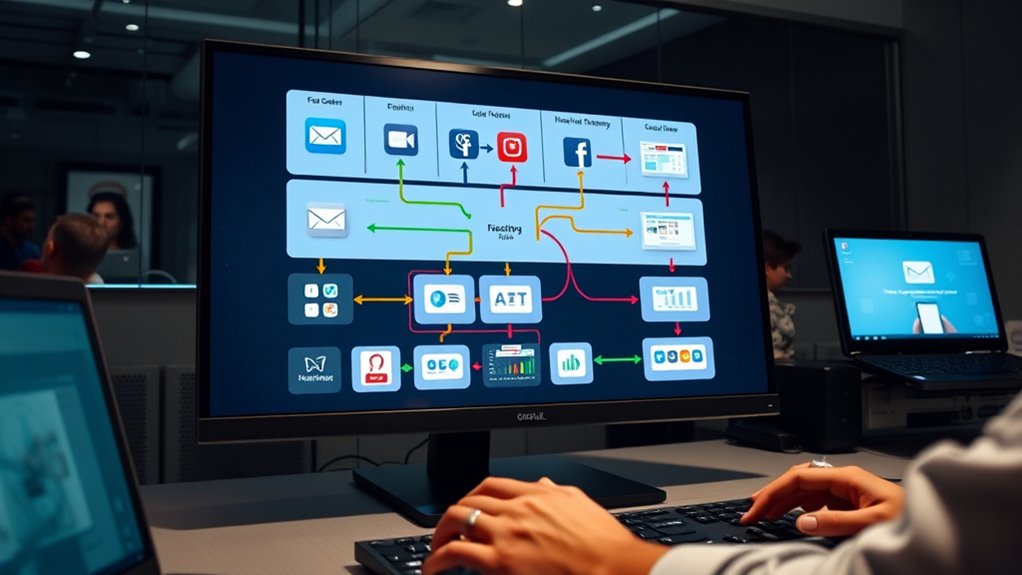Sequential retargeting helps you craft multi-step ad funnels across channels by using behavioral triggers and personalized messaging to guide prospects through their buyer’s journey. You can plan ad sequences that build trust, engage emotional responses, and lead to conversions. Leveraging various platforms, such as social media, emails, and websites, creates seamless, consistent experiences. Mastering these strategies will help you boost engagement and conversions—keep exploring to discover how you can optimize every step.
Key Takeaways
- Structure ads sequentially to guide prospects from awareness to conversion through storytelling and consistent branding.
- Use behavioral triggers and audience segmentation to deliver personalized, timely messaging across multiple channels.
- Create seamless user journeys by integrating social media, websites, email, and retargeted ads for cohesive engagement.
- Monitor key metrics and conduct A/B testing to optimize ad sequences, timing, and creative effectiveness.
- Ensure cross-channel consistency and emotional resonance to build trust and maximize conversion rates throughout the funnel.
Understanding the Concept of Sequential Retargeting

Have you ever noticed how online ads seem to follow you across different websites? That’s the core idea behind sequential retargeting. It uses behavioral triggers to identify when someone interacts with your content or products. These triggers help you understand what captures your audience’s interest, allowing you to serve more relevant ads. Audience segmentation plays a vital role here, dividing users into specific groups based on their actions, preferences, or engagement levels. By doing this, you can craft a series of ads that guide prospects through their buyer’s journey, building familiarity and trust step by step. Sequential retargeting isn’t just about repetition; it’s about delivering the right message at the right time, based on how your audience responds. Recognizing Relationship Dynamics can also help tailor your messaging to resonate more deeply with your audience. Incorporating behavioral data analysis enhances the effectiveness of your retargeting strategies by providing deeper insights into user actions. Leveraging customer segmentation allows marketers to personalize content further, increasing engagement and conversion rates. As cyber threats evolve, integrating AI Security into your marketing and data protection strategies becomes increasingly important to safeguard sensitive information.
Designing Effective Multi-Step Ad Funnels

Creating an effective multi-step ad funnel requires carefully sequencing your ads to guide prospects from initial awareness to final conversion. Focus on using creative storytelling to build an emotional connection at each stage, ensuring your message resonates and motivates action. Maintain visual consistency across all ads to reinforce brand recognition and create a seamless experience. Each step should build on the previous one, gradually increasing engagement and trust. Use compelling visuals and clear calls-to-action that align with the stage’s goals. Incorporating boho decor themes can also help establish a distinctive brand personality that appeals to your target audience. Paying attention to wall organization strategies can further enhance the aesthetic appeal of your visual content, making your ads more engaging. By thoughtfully designing your funnel with cohesive messaging and visuals, you’ll guide prospects smoothly through the buyer’s journey. Implementing AI content clusters can further enhance your strategy by ensuring your messaging is highly relevant and targeted at each stage. Additionally, understanding asset division laws can help tailor your messaging to specific audience concerns about legal and financial processes. Integrating juice cleanse principles of nutrient-rich ingredients can inspire your content to emphasize health benefits and wellness, making your messaging more compelling. This strategic approach helps maximize conversions and creates a memorable, impactful experience for your audience.
Leveraging Multiple Channels for Seamless User Journeys

Why is it essential to leverage multiple channels in your marketing strategy? Because retargeting dynamics thrive on cross channel synergy, creating consistent touchpoints that guide users effortlessly. Imagine:
- A user sees an ad on social media, sparking interest.
- They visit your website but leave without converting.
- Later, they encounter a personalized email reminding them of your offer.
- Finally, they see a retargeted ad on a different platform, reinforcing the message. Additionally, understanding the importance of visual and audio feedback can help in designing campaigns that resonate emotionally and build trust across channels.
Personalization and Timing in Sequential Campaigns

Building on the power of cross-channel retargeting, tailoring your messages through personalization and well-timed interactions can substantially boost engagement. Use behavior cues to identify your audience’s interests and intent, allowing you to craft relevant messages at each step. Audience segmentation helps you group users based on their actions, ensuring you deliver the right message at the right moment. Timing is essential; reach out when users are most receptive, such as after a specific action or at key points in their journey. Personalization makes your ads more compelling, increasing the likelihood of conversion. Regularly cleaning and updating your email list also enhances deliverability and engagement. Incorporating essential oils into your messaging can create more relatable and soothing content, resonating better with your audience. Additionally, focusing on sleep and mental health in your messaging can improve receptivity, especially when aligned with user behaviors and preferences. Understanding skincare routines and how they influence user engagement can further optimize your campaigns. Implementing knowledge about lifestyle habits can help you craft more targeted and effective outreach strategies. By aligning your messaging with user behaviors and carefully timing your outreach, you create a more effective, seamless experience that guides prospects toward taking action.
Measuring Success and Optimizing Your Funnel

To effectively improve your retargeting efforts, you need to measure the success of each stage in your funnel and identify areas for optimization. Focus on key conversion metrics like click-through rates, bounce rates, and completed purchases. Use A/B testing to compare different creatives, messaging, and timing strategies, revealing what resonates best. Visualize your funnel as four layers:
- Awareness – Are your impressions generating clicks?
- Engagement – Do visitors interact with your content?
- Conversion – Are they completing desired actions?
- Retention – Do they return or convert again? Incorporating performance tuning techniques from Hyundai tuning practices can help optimize your ad campaigns for better results. Additionally, understanding the privacy and cookie implications can guide more targeted and compliant strategies. Tracking these stages helps you pinpoint drop-offs and optimize accordingly. Regularly analyze your data, refine your messaging, and test new strategies to maximize your funnel’s performance and ROI. Incorporating a holistic approach to your analytics can help you better understand how various channels and strategies work together to support overall success. Recognizing the significance of skin health benefits from eye patches can also inform your creative messaging and value propositions for better engagement.
Frequently Asked Questions
How Do I Identify the Best Touchpoints for Each Step?
To identify the best touchpoints for each step, you should analyze your customer journey thoroughly. Use touchpoint mapping to visualize where prospects interact with your brand, both online and offline. Pay attention to engagement levels and conversion data at each point. This approach helps you pinpoint which touchpoints are most effective for moving customers through the funnel, allowing you to optimize your messaging and channels for better results.
What Budget Allocation Strategies Work Best for Multi-Step Funnels?
You should allocate your budget based on retargeting timing and audience segmentation. Start by investing more in early-stage retargeting to build awareness, then increase spending as your audience moves through the funnel. Use audience segmentation to identify high-intent groups, dedicating more budget to those segments. Adjust your allocations dynamically, monitoring performance, so you maximize engagement and conversions at each step of your multi-step funnel.
How Can I Prevent Ad Fatigue Across Multiple Channels?
Did you know that 47% of consumers become annoyed when ads are repetitive? To prevent ad fatigue across multiple channels, you should implement creative rotation to keep content fresh and engaging. Additionally, audience segmentation helps tailor your ads, reducing overexposure for the same group. These strategies guarantee your campaigns stay relevant, maintain user interest, and improve overall ad performance.
What Tools Assist in Managing Complex Sequential Retargeting Campaigns?
You can manage complex retargeting campaigns using tools like HubSpot, AdRoll, or Google Campaign Manager, which help track attribution models and refine audience segmentation. These platforms allow you to automate multi-step ad funnels, adjust messaging based on user behavior, and optimize across channels. By leveraging attribution data and segmenting audiences precisely, you guarantee your retargeting remains effective, reduces ad fatigue, and drives conversions seamlessly.
How Do I Ensure Consistent Messaging Across Diverse Platforms?
Ironically, keeping your message consistent across platforms feels like herding cats. Yet, it’s all about brand consistency and message alignment. Use brand guidelines, unified visuals, and clear tone of voice to guarantee your message stays on point. Automate where possible, and review campaigns regularly to catch drift. You’ll create a seamless experience that reinforces your brand, no matter where your audience encounters it.
Conclusion
Now that you’ve grasped the power of sequential retargeting, you’re ready to craft multi-step funnels that guide users smoothly across channels. Think of it as your own digital renaissance—aligning timing, personalization, and channels like a master artist. Keep measuring and tweaking your approach, and you’ll turn browsers into loyal customers. With this strategy, you’ll be ahead of the curve, even in a world that moves faster than a DeLorean.










